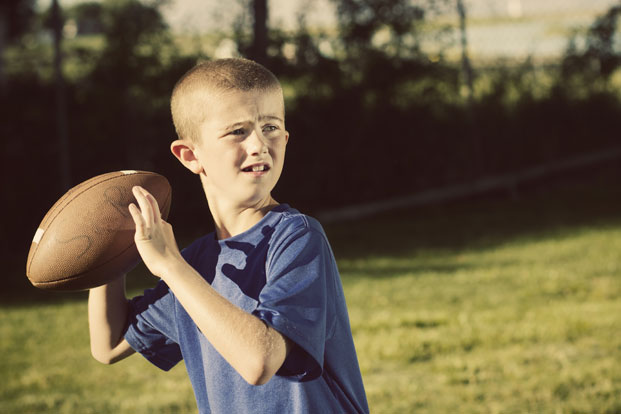More than 38 million American children participate in youth sports each year. Of those, more than 3 million will visit an emergency room each year with a sports-related injury. Some will have sprained ankles or broken bones, and others will be admitted to treat a concussion or head and neck trauma. These numbers, gathered by the Center for Injury Research and Policy at Nationwide Children’s Hospital in Columbus, also don’t take into account the untold thousands of injuries that are treated by athletic trainers, in clinics, or through visits to family doctors and pediatricians.
While injuries happen in all sports that children play, there are some sports that have a greater risk of injury. Numbers are skewed, of course, because of the popularity of certain sports over others. This list examines the five most dangerous sports for American children, taking into account both total injuries and individual risk of injury by sport.
5. Hockey
Total ER Visits: 21,145
Hockey has been gaining in popularity among youth athletes and has become the sixth most popular sport in the United States. Youth participation in the sport has nearly doubled, with numbers increasing from around 200,000 in 2000 to more than 350,000 in 2012, according to the American Academy of Pediatrics. Student athletes who play hockey are at a risk for concussions, torn ligaments, groin pulls and lacerations from falling on ice.
What makes this sport most controversial is the practice of “checking” – full-body defensive blocks of whoever is in control of the puck. USA Hockey allows checking with the 11-12-year-old Pee Wee League, but a recent American Academy of Pediatrics study recommended raising the age to 15. Researchers from the Center for Injury Research and Policy at Nationwide Children’s Hospital in Columbus urge parents to make sure all kids wear face masks while playing.
4. Soccer
Total ER Visits: 99,068
The World Cup has helped boost the popularity of the sport known as football to the rest of the world and soccer to Americans. Because of increased participation, doctors see an increase in soccer-related injuries. According to a study published by Nationwide Children’s Hospital, 8.2 percent of all sports concussions occur while playing soccer.
Girls may be at a particularly high risk for soccer-related injuries. News reports have shown girls may suffer neurological injuries because their necks are not strong enough to “head” the ball. Female athletes are encouraged to learn how to head the ball properly to avoid injury and should do strength training exercises to avoid leg injuries, because teenaged girls who play soccer are more likely to suffer from torn anterior cruciate ligaments (ACL) in the knee than their male counterparts.
3. Baseball/Softball
Total ER Visits: 112, 577
According to a 2012 ESPN study, youth baseball is the most popular organized sport for athletes between the ages of 6 and 8 and is the second most popular organized sport (behind basketball) for young student athletes until high school.
Unlike other sports on this list, most of the injuries baseball players suffer are minor and affected upper extremities. According to a study published in the Journal of Athletic Training, injury rates for baseball are highest in the first month of the season and tend to drop off later.
2. Basketball
Total ER Visits: 189,562
Basketball has the highest numbers for participation by both male and female athletes between the ages of 6 and 17, and the emergency room visits don’t take into account the many thousands of injuries treated by clinics, athletic trainers, family doctors and pediatricians.
Basketball injuries account for 9 percent of youth concussions, second only to football. Basketball’s numbers are inflated, of course, by the large numbers of participants. In terms of individual risk, concussion rates among 12- to 17-year-olds are highest for ice hockey (29 per 10,000 players), followed by football (27), soccer (8), basketball (4) and baseball (3).
1. Football
Total ER Visits: 240,509
Football is the most popular sport in America, based on TV viewership. In 2012, 46 of the top 50 most-watched TV events were National Football League (NFL) games. So it’s no wonder that football is one of the most popular sports for student athletes. It’s also the most dangerous: 80 percent of concussions that kids get while playing sports are received playing football. With more than 3 million students playing football each year, that’s a lot of concussions.
Repeated blows to the head, whether resulting in a concussion or not, potentially can be even more dangerous. Over time, they can lead to chronic traumatic encephalopathy (CTE), a progressive degenerative disorder in which brain tissue is damaged, causing memory loss, confusion, impaired judgement, diminished impulse control and other problems. And while helmets are designed to offer some protection, there has not yet been a helmet designed that protects against concussions.
What Can I Do?
Regardless of what sport your student athlete is playing, it’s essential that you play a role in minimizing his or her risk of injury. Stay up to date on safety gear and work with your school or athletic organization to ensure that all the players are being given the best safety gear. Be wary of old or broken safety equipment, which can actually increase a child’s risk of injury.
Get involved: Make sure that your student athlete knows how to handle him or herself properly on the field. If there are actions that have particularly high risk, like “heading” the ball in soccer or tackles and hits in football, work with your student athlete on how to perform those actions in the safest way possible.

Leave a Reply